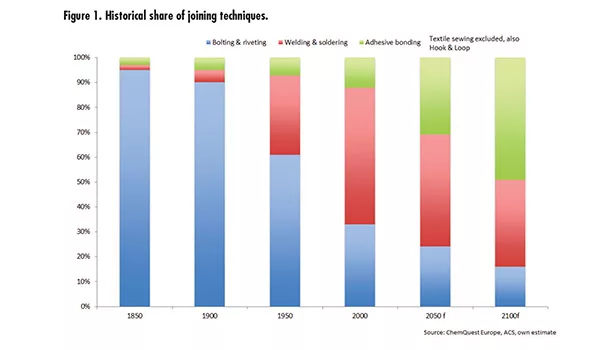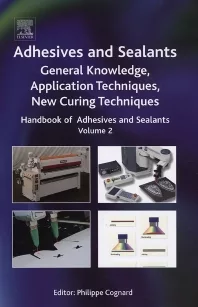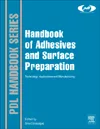Strategic Solutions: The Future of Adhesives and Sealants
The 21st century will be characterized by chemical joining and bonding.

It is no secret that the performance of adhesives and sealants is advanced through polymer science. Enhanced bonding performance and specialized functionality—such as flexible gap filling, electric and/or heat conductivity, corrosion protection, and noise and vibration damping—are developed to meet unmet needs in industrial and consumer applications.
Rapid progress in the adhesives industry is being achieved through new macromolecular chemistry, raw materials and additives, as well as highly sophisticated dosing, metering, and dispensing equipment and state-of-the-art curing processes. These have allowed for custom bonding solutions that are outperforming conventional fastening and soldering techniques relative to flexibility, design freedom, and material compatibility while delivering excellent cost/performance benefits.
The material science behind chemical bonding has evolved unimaginably over the past 5,000 years, with technological advances accelerating rapidly after World War II. To fully appreciate the future of adhesives, let’s review the conventional joining techniques that adhesives have replaced and the reasons behind it.
Evolution of Joining Techniques
Historically, classic fastening techniques involved nails, rivets and bolts, with adhesive bonding limited to natural glues for woodworking, paper, book binding, and packaging. Animal glues, tree resins and rubbers from tropical wood and bitumen were typical bases. In 19th-century Europe, scientific curiosity was virtually nonexistent with respect to improving adhesion properties. Instead, advancements in bonding were predicated on empirical evidence resulting from trial-and-error experimentation. The pace of technical advances in bonding was as slow—as Antonio Stradivari can attest with the painstakingly slow pace of producing the Stradivarius violin!
Heavy-duty fastening (bolting and riveting) was required for engines, ships and machinery. The use of soldering, a joining method of ancient origin used for the assembly of precious jewelry, grew exponentially with the use of electricity.
Welding was born when advancements in metallurgy coincided with on-the-spot generation of acetylene and the availability of pure oxygen from air liquification; it evolved due to innovations ranging from electric sparks to inert-gas welding to highly sophisticated laser joining. Innovations in welding have peaked, however; current welding applications are limited to same-material combinations given their thermal activation.
Adhesive Joins Gain Strength
Demand in joining today is based on lightweight, dissimilar substrates with high structural stability requirements in applications such as aerospace, automotive, building and construction, and consumer electronics, which prohibit drilling and/or thermal load. Adhesives took off following the introduction of synthetic polymers, with a major breakthrough after World War II. Technologies such as melamine, epoxy, polyester, acrylate, methacrylate and polyurethane became widely available for adhesive formulations. These technologies were complemented by polyvinyl acetate, polychloroprene, silane-terminated polymers, and specialty materials such as cyanoacrylates and polysaccharide derivatives, which provided a range of formulating options.
Today, custom blends are available for bonding nearly any material combination and every load and service life. Integration of adhesive bonding into serial assembly operations is relatively easy to achieve. Additional factors that contribute to good adhesion include permanent progress in metering, dispensing and dosing equipment, and in the design of adhesive bonds; in-line technologies for surface preparation and curing; growing user experience; and material reliability.
Until recently, a lack of user experience, non-destructive testing, and proper training and education of personnel were barriers for selecting adhesive joining over other methods. Since the 1970s, those barriers continue to be addressed by a wide spectrum of academia, industrial associations and specification bodies, as well as the value chain.
Joining expenses represent a maximum of 1% of the manufacturing costs of goods. Thus, adhesives are an almost negligible cost factor, yet highly important when the application demands high tensile strength, reliability, flexibility, versatility and other performance properties.
The 21st century has ushered in a number of mega trends, such as population and demographic changes, sprawling urbanization, growing food shortages, dwindling resources, counter-measures against climate change, and de-carbonization of energy generation, as well as growing digitalization and connectivity. Foreseeably, sustainability will be mandated throughout the value chain.
Modern adhesives and sealants will be key enablers for achieving goals of global sustainability through advances in polymer science and technologies, breakthroughs in hybrid and multi-component formulations, and new equipment and curing techniques. Just as the 20th century was transformed by welding, and the 19th century was dominated by riveting and bolting, so too will the 21st century be characterized by advances and above-GDP growth attributable to adhesive bonding.
Any views or opinions expressed in this column are those of the author and do not represent those of ASI, its staff, Editorial Advisory Board or BNP Media.
Looking for a reprint of this article?
From high-res PDFs to custom plaques, order your copy today!






